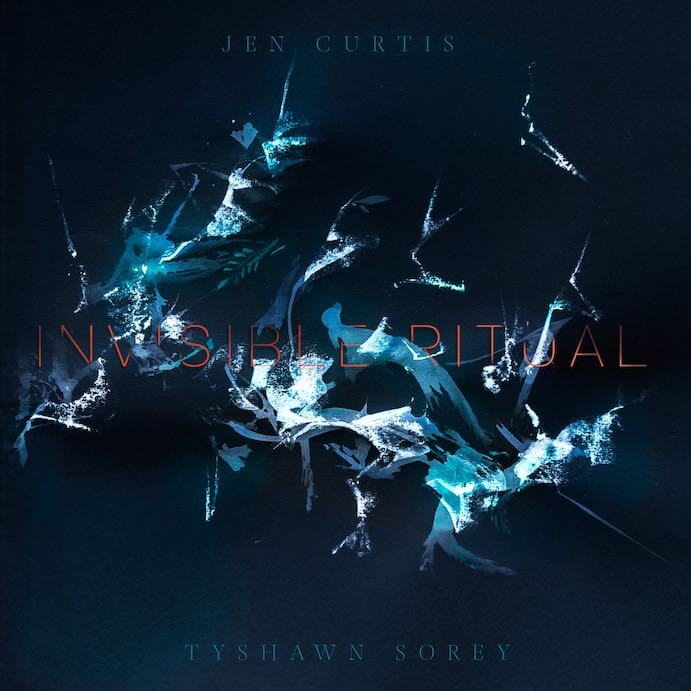Here’s a one-word review of Jennifer Curtis and Tyshawn Sorey’s collaborative album Invisible Ritual: finally. Alternatively, epic. Try for three, and genius loves company almost works. Words always fail to capture the character of music, but here, more words equal deeper failure. Brevity beckons. The best possible two-word review may be the album’s title: it draws listeners inescapably into unseen acts of magic.
The record comprises the eight-track title piece, which Sorey and Curtis improvised while recording. Their planning process consisted entirely of their history of collaboration plus deep conversations on the way to the session. The problem finding words for what they achieved together is that description is a clumsy tool made of slippery language. How can imprecise words nail down vaporous traces of mood, muscle memory, and thought? Invisible Ritual invites wordless murmurs of appreciation, perhaps soft expletives of amazement.
Sorey and Curtis walked into record producer Randy Ezratty’s living room in 2018 with substantial reputations in place. Curtis, a composer and master in many styles, plays violin for the International Contemporary Ensemble, whose Tundra imprint released this record. Sorey, a pianist, percussionist, and MacArthur Fellow, has composed in a staggering variety of contexts and collaborated with seemingly everyone. Yet Invisible Ritual finds defining aspects of both musicians’ approaches in absorptive consonance with each other.
Tyshawn Sorey (photo: John D. & Catherine T. MacArthur Foundation)
Ryan Streber of Oktaven Audio catches every splash, thump, and strum at the start of I. For this, listeners owe him gratitude. Sorey and Curtis never overwhelm one another, and their softest sounds remain ever audible. Picture a painting of a drummer by Basquiat, right next to a Rockwell illustration of a country fiddler. Imagine that you found their gallery in a dream, and that a shaft of sunlight abruptly woke you. The dream remains lodged in your mind, albeit distorted: that’s I.
Convergences seem too perfect to have emerged spontaneously in II., but from this duo, flights and figments feel like culminations. Curtis’s harmonics open high above Sorey’s toms, but together they flow toward airiness–her on strings, him on scraped cymbals. Gongs and an erhu-like violin tone suggest memories of Chinese music. A tart piano chord jolts III. into existence; after answering with mournful double stops, Curtis steps aside for a while. New Focus Recordings label head Dan Lippel suggests inspiration from Feldman here, but the climax and conclusion offer unique appeal. After Curtis returns with furious arpeggios, Sorey walks up the keyboard in spacey perfect fourths; both end up adrift.
The violin melody that opens IV. and serves as a reference point throughout is also an earworm; consider yourself warned. Scraps of familiar styles drift by, prompting questions rather than recognition–which Romantic violin concerto has that tune? Which rock drummer played fills like this? It ends with a playful ellipsis that Sorey, back on piano for V., answers with a different kind of playfulness. His blips conjure images of a hacked player piano reproducing bits of Ahmad Jamal solos. Curtis coughs, reminding us that this is happening live in someone’s living room–but also scales the heights of virtuosity.
Jennifer Curtis
With Curtis on a melancholy tune and Sorey harmonizing and embellishing, VI. sounds more like jazz than other tracks. Angst steals in and shatters the balladry, however. VII. seems like a logical conclusion at first, with its recall of I. and its mounting energy. Sorey’s late cymbal scrape, followed ten seconds of silence later by a bass drum thump, feels conclusive. Yet the ritual of the title can end in neither sorrow nor lightheartedness. VIII. pairs ruminations from Curtis with the chiming bells, bowls, gongs, and cymbal crowns of Sorey’s percussion setup. The duo remains tight to the end, Curtis catching pitches from Sorey’s tuned gongs and working the notes into melodies.
Invisible Ritual’s flickers of the familiar feel necessary and grounded, fun but not emptily so. It rewards immediate repeat listening, but its scale means that doing so would make an afternoon of it. I recommend that. Once, having loaded the album onto my phone for a long run, I arrived at the edge of a park. Unknown to me before that day, blanketed in fog and deserted but for geese, it invited a pause. On one edge, a steep hill made it look as though the world abruptly ended there. To the left, ramshackle old houses huddled; to the right, anonymously sleek new condominiums had just gone up. III. made for the perfect soundtrack: slightly surreal, somehow dark yet luminous, a clouded summation of our zeitgeist. Invite Sorey and Curtis into your space and see how they change the lighting.

